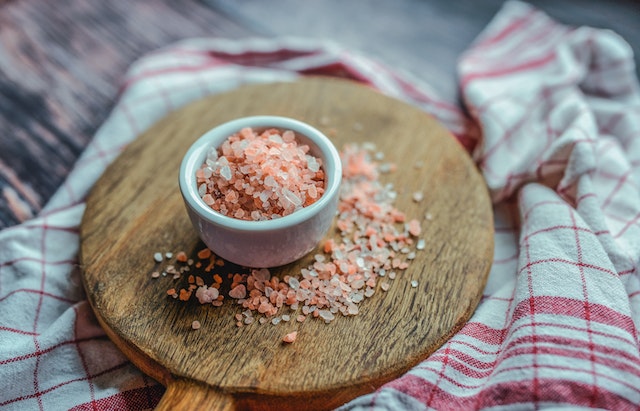Does Too Much Salt Cause Cramp?
Contrary to popular belief, the body needs a small amount of salt to work properly.
However, often you will hear how many modern diets may contain too much salt (or sodium).
This leads to confusion as to how much to consume, and also concerns about the negative effects of this, such as muscle cramps.
Here we will take a closer look at how salt levels can be linked to muscle cramp
Author: Josh Matthews (BSc MS)
Are Salt and Sodium The Same?
Salt and sodium are related but not the same.
Salt is a compound that consists of two elements: sodium (Na) and chloride (Cl).
Sodium is a chemical element, while salt is a compound that forms when sodium bonds with chloride. In other words, sodium is a component of salt.
When discussing dietary recommendations or sodium intake, the terms “salt” and “sodium” are often used interchangeably, but it is important to recognize the distinction between them.
The sodium content of a food item is typically measured and listed on nutrition labels, even though the source of that sodium is salt.
For example, if a food label indicates that a serving contains 500 mg of sodium, it means that the food contains 500 mg of sodium ions derived from the sodium chloride (salt) in the food.
Table salt is made up of just under 40% sodium by weight. So a 6g serving (1 teaspoon) contains about 2,400 mg of sodium.
To manage your sodium intake, you’ll need to consider both the sodium content in foods and the amount of salt you use in cooking and seasoning.
How Much Sodium Do We Need Each Day?
The recommended daily intake of sodium can vary based on factors such as age, gender, physical activity level, and overall health.
Dietary Guidelines for Americans (2020-2025):
- Adults should aim to consume less than 2,300 milligrams (mg) of sodium per day.
- Individuals who are 51 years of age and older, and those of any age who are African American or have hypertension, diabetes, or chronic kidney disease, should aim to consume no more than 1,500 mg of sodium per day.
World Health Organization (WHO):
- The WHO recommends a maximum sodium intake of 2,000 mg per day for adults.
Please note that these recommendations pertain to overall sodium intake from all sources, including processed foods, restaurant meals, and home-cooked meals.
It is important to be mindful of the sodium content in your diet, as many processed and packaged foods can be high in sodium.
Keep in mind that these recommendations are general guidelines and that individual needs can vary. Some people may need to consume more or less sodium based on their specific health conditions or circumstances.
It is always a good idea to consult with a healthcare professional or a registered dietitian for personalized dietary recommendations.
Lastly, it is important to focus not only on sodium intake but also on the balance between sodium and other electrolytes like potassium and magnesium.

Can Consuming Too Much Salt Cause Muscle Cramps?
Consuming too much salt (sodium) may potentially contribute towards muscle cramps.
Contrary to popular belief, most dietary sodium (over 70%) comes from eating packaged and prepared food, and not from table salt added to food when cooking or eating.
Salt plays a crucial role in maintaining the balance of fluids in your body, including the balance of electrolytes like potassium and sodium.
These electrolytes are essential for nerve signalling, proper muscle function, and fluid balance.
When you consume excessive amounts of salt without balancing it with enough fluids or other electrolytes like potassium, it can disrupt the delicate electrolyte balance in your muscles and nerves.
This imbalance may lead to muscle cramps, especially during physical activity or when muscles are stressed.
Athletes and individuals who engage in intense physical activities are particularly susceptible to imbalances in electrolytes due to excessive sodium secretion during exercise.
However, even if you are not very active, consistently consuming high amounts of salt can contribute to an electrolyte imbalance and potentially increase the risk of muscle cramps.
High Sodium Foods To Avoid
About 40% of the sodium consumed by Americans comes from the following foods:
- Deli meat sandwiches
- Pizza
- Burritos and tacos
- Soups
- Savory Snacks (e.g. chips, crackers, popcorn)
- Poultry
- Pasta mixed dishes
- Burgers
- Egg dishes and omelets
Do Athletes Require More Sodium In Their Diet?
The American College of Sports Medicine recommends that endurance athletes consume 300-600mg sodium an hour (which equates to 1.7-2.9g salt) during prolonged exercise.
However, sodium losses vary from person to person depending on factors such as exercise intensity, duration, ambient temperature, body size, age, sex, and clothing, and sodium intake should be individualized to the athlete.
Endurance athletes need more sodium than the general population because they can lose up to 2L of sweat an hour during exercise, and sodium losses range from 460-1840 mg/L of sweat.
Whilst some studies exist which back up the theory that sweating leads to sodium loss, which then leads to cramps. Other studies demonstrate that athletes in colder climates experience cramp also.
How To Prevent Muscle Cramps Related To Salt Consumption?
There are ways in which you can reduce the chance of developing muscle cramp.
Moderate Your Salt Intake
Be mindful of the amount of salt you are consuming as part of your diet. Avoid excessively salty foods and read food labels to monitor your sodium intake.
Stay Hydrated
Drink enough water throughout the day to help maintain a proper balance of electrolytes in your body.
Eat Electrolyte Rich Foods
Reducing the processed foods mentioned above is an important step in reducing cramps related to excess muscle cramp. But what do we replace them with?
Potassium is another important electrolyte for muscle function. Consuming foods like bananas, oranges, potatoes (especially sweet potatoes), spinach, and yogurt can help balance your electrolyte levels.
Also consider foods which contain magnesium and calcium.
Overall, aim for a well-rounded diet that includes a variety of nutrients to support overall health and muscle function.
How Do I Know That Salt Consumption Is Causing My Muscle Cramps?
It is worth noting that while excessive salt intake can contribute to muscle cramps, there may be other causes as well
For example, muscle fatigue, dehydration, and underlying medical conditions may cause cramp.
If you experience frequent or severe muscle cramps, it is a good idea to consult with a healthcare professional to determine what the underlying causes may be, and receive appropriate guidance.
Also check out our articles here at curemycramp.com for more info on muscle cramp and it’s causes.
Conclusion
Hopefully this in-depth look at salt/sodium and it’s relation to cramp has been helpful.
Although there are some doubts still amongst the scientific community that sodium plays a role in muscle cramp, the general consensus is that having adequate amounts of sodium and other electrolytes in your body plays a key role in reducing muscle cramps.
Sodium needs vary from person to person, and often you will need to find out what your needs are through trial and error. Use government recommended daily intakes as a guide.
However by taking a common sense approach to your diet, it is often easy to regulate your salt intake, and reduce any muscle cramp.
You may wish to check out our article on foods to help with muscle cramp by clicking this link.
Disclaimer: All information on this site is for information only, and not intended to replace the advice of a qualified medical professional. curemycramp.com and any writers associated with this website accept no responsibility for circumstances arising from the use of information on this site, without consulting a registered health professional first.


